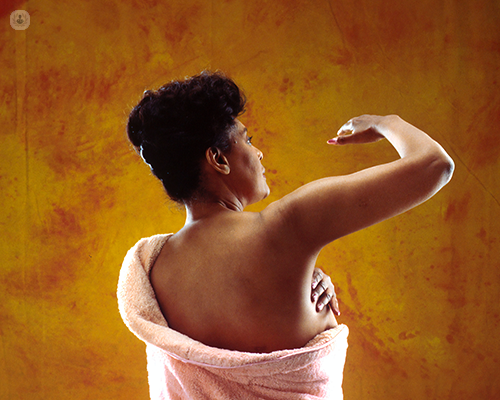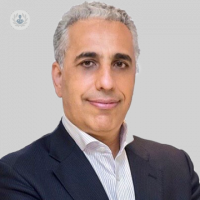Savi Scout®: A breast cancer surgery advancement
Escrito por:Savi Scout® is a promising advancement in breast cancer removal surgery. Professor Kefah Mokbel is a leading London oncoplastic surgeon with expert knowledge of this exciting new development, and here he provides you with insight into how this device is transforming breast cancer surgery for the better. He also explains what to expect while undergoing the procedure.

What is Savi Scout® wireless localization?
Savi Scout ® guided localisation is a new procedure for treating early-stage breast cancer. It’s a device that’s used when the surgeon needs a guide to surgically remove an area of breast tissue that cannot be felt through clinical examination. This guide (Savi Scout) ensures he or she accurately removes the correct piece of tissue during surgery.
How does it work?
Savi Scout uses a radar for a zero-radiation and wire-free solution. It’s designed to help surgeons locate the cancerous and abnormal tissue during a lumpectomy to more than 1mm of accuracy. Instead of wires, SAVI SCOUT® uses a reflector that measures 1.2 cm by 1 mm.
The end of the Savi Scout device can be placed in the abnormal breast tissue that needs to be removed. This is done by a breast radiologist (a doctor who specialises in mammography and breast ultrasound ) at any time before surgery during an outpatient ultrasound scan or mammogram.
The reflector isn't externally visible, and placement does not restrict your movements. The reflector is passive until activated and when safe, non-radioactive radar waves are used to detect it within your breast. The non-radioactive surgical guidance technology then guides your surgeon to the precise site of your tumour and can increase the likelihood of a complete removal of the tumour.
How does Savi Scout compare to alternatives?
The standard alternative is wire-guided surgery, which was invented nearly 50 years ago yet is still the global standard in breast cancer removal surgery. However, this is a relatively invasive procedure that involves the insertion of a stainless steel guidewire on the day of surgery, which can cause discomfort and takes longer to perform that wire-free surgery. Also, the scar from wire-guided surgery may be inaccurately sited, making the surgical procedure more difficult to perform. The surgeon may have to remove more breast tissue than necessary to ensure completeness of the cancer or pre-cancer removal.
Other wireless breast localization options include the use of magnetic seeds (Magsees®) or radiofrequency tags (LOCalizer®), both of which interfere with breast MRI scans.
Which breast cancer removal method do you prefer?
Having evaluated all three technologies in clinical practice, I have chosen the Savi Scout system as my preferred approach. Technology is advancing and Savi Scout is transforming the way breast cancer surgery is performed by overcoming many of the shortcomings of guidewires.
What are the benefits of Savi Scout localisation?
This wireless localization method removes the discomfort and inaccuracy of breast guidewires. It also removes the scheduling inflexibility of guidewires that can delay surgery. Tailored for locating breast abnormalities before a breast lumpectomy, the Savi Scout system makes the process more comfortable for patients and more efficient for doctors and healthcare providers. This makes better outcomes for everyone.
How is the wireless reflector inserted?
In the procedure, the reflector is inserted by a radiologist. The procedure is similar to the core needle biopsy you would have had in the test that confirmed your breast cancer diagnosis.
- You will attend the breast radiology suite and have an ultrasound scan or mammogram of your breast to locate the cancer or pre-cancer.
- The breast radiologist will then inject a local anaesthetic into your breast. This may sting for a few seconds but will numb your breast quickly.
- The radiologist will then use a needle to place the reflector tag into the area of breast abnormality that requires removal. You may feel some pressure in your breast during the procedure but this is not usually painful. If you do feel any pain, please make the radiologist aware so that more local anaesthetic can be injected to relieve any acute pain.
- You will not be able to feel the marker once it is inserted and you can continue with your normal activities. A small dressing will be placed over the needle puncture site after applying Steri strips.
- The procedure will usually take about 5 minutes.
- The radiologist will arrange a special mammogram picture to check the position of the Scout marker to ensure it is in the correct position. You may have some mild discomfort and bruising after the procedure. Simple pain killers are available if you have significant discomfort or pain.
What happens during surgery?
In the operating room, the surgeon uses a special probe attached to a radar to precisely locate the reflector and therefore, find the abnormal tissue to be removed. The reader will show the surgeon the distance in millimetres between the reflector marker and the probe. This allows continuous navigation in real-time – ultimately allowing the surgeon to remove the abnormal tissue accurately.
After surgery, the surgeon will arrange a mammogram of the breast(s) to confirm that all cancerous tissue was accurately removed.
What are the risks of Savi Scout localisation?
Compared with other standard localization techniques, there are no known health risks associated with Savi Scout.
The standard risks of infection and bleeding are uncommon and apply to all localization procedures. The reflector (marker) placed in the breast can rarely fail to reflect the signals generated by the external console and if this happens, a second method of localization will be used on the day of surgery.
The reflector contains a tiny amount of nickel and therefore it should not be used in patients with a nickel allergy.
What happens after the Scout localisation?
You can remove the dressing the next day. You can also return to work and most activities the following day.
You can have a shower or bath the following day, but it is wise to avoid swimming for 48 hours. It’s also recommended that you wear a sports bra for 24 hours for comfort.
References
- IHAM KASEM and KEFAH MOKBEL
Savi Scout® Radar Localisation of Non-palpable Breast Lesions: Systematic Review and Pooled Analysis of 842 Cases. Anticancer Research, 2020 (in press)
You can receive Professor Mokbel’s leading oncoplastic breast services – learn more and reserve your consultation.


